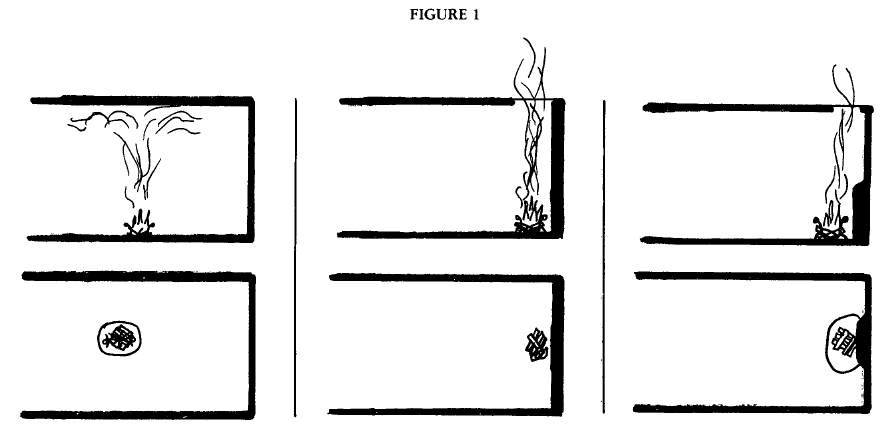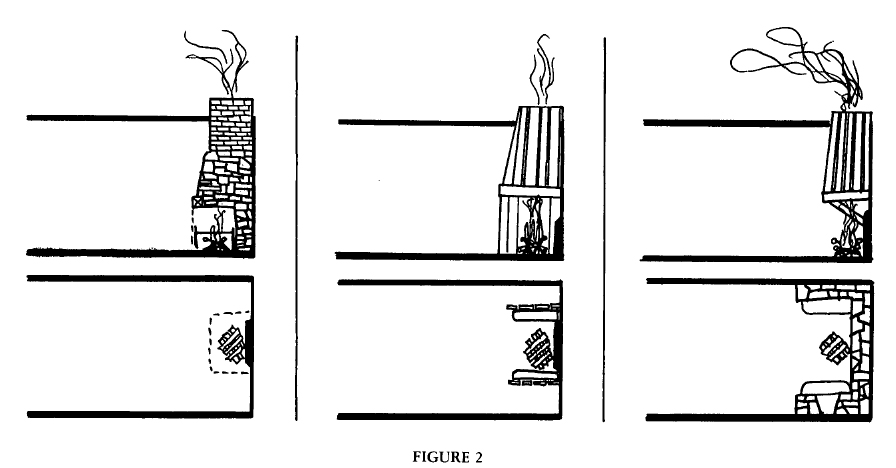Interior Forms - Interior Functions
The Development of Cooking and Heating Technology in the Newfoundland House
Abstract
This paper deals with the evolution of the Newfoundland fireplace and with the earliest forms of cooking and heating technology as well as with the interaction of available technology and actual practice in Newfoundland in the nineteenth century.
Résumé
Cet article porte sur l'évolution du foyer à Terre-Neuve, sur les premières techniques de cuisson et de chauffage ainsi que sur les liens entre les techniques existantes et celles qu'on employait effectivement dans cette colonie au ⅪⅩe siècle.
1 Because of the relative inaccessibility of materials on cooking and heating technology this paper can only have a limited analytic base and should be seen as a survey. What is looked at here is the advance of the technology from the open fire through grates and ranges to stoves, that is, until the beginning of the twentieth century.
2 In the earliest Newfoundland houses — the tilts — the fireplace took a variety of forms to judge from the various descriptions given by travellers. These accounts all date from the nineteenth century but it is reasonable to assume, knowing the survival of other types of technology, that the manner did not differ greatly in previous centuries. Julian Moreton in 1863 mentions the simplest form of open fire: "a flat rock forms the hearth, and the chimney is simply a space left uncovered in the end of the roof."1 Others mention chimneys of "upright studs, stuffed ... with moss," of "rough unmortated stones," and a fireplace "partially enclosed with boards, and having within a bench on each side, so as to admit 8 or 10 persons.2
3 These references suggest a technological development which is borne out by surviving examples as well as examples known from cognate cultures.3 The pattern is as follows (figs. 1 and 2): an open fire in the centre of the house or at the gable with no smoke-hole, the smoke settling in the roof covering; an open fire with a smoke-hole; an open fire with a fireback and a smoke-hole; an open fire with a fireback and a studded hood chimney; an enclosed fireplace with a studded chimney; and an enclosed fireplace with a stone chimney. The technological development is in the movement away from a smoky fire which wastes heat and has a tendency to burn the roof, towards a fireplace which - in a limited fashion - conserves the heat and directs the smoke up a non-flammable chimney. It should be noted that this development pattern is nor bound by time, that is, there is no suggestion that this is how the Newfoundland fireplace evolved. Rather the pattern is indicative only of the process of improvement - of technological rather than chronological development.4 The more primitive forms could be found throughout Newfoundland in the nineteenth century and, in temporary situations of fishery and logging, can still be found in this century.
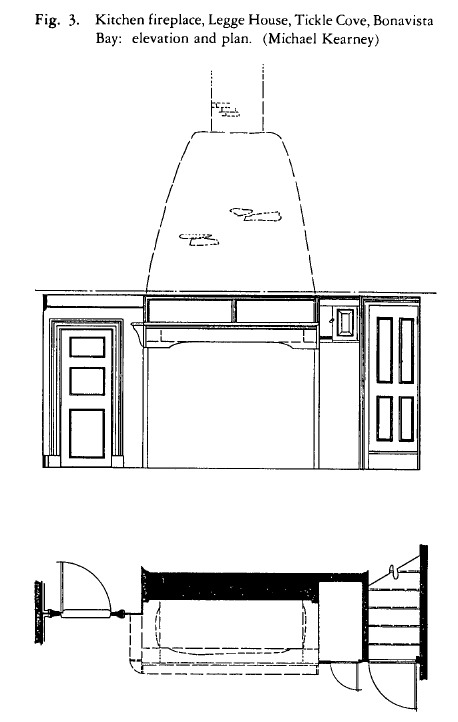 Display large image of Figure 3
Display large image of Figure 34 But where does the settle fireplace come into this? It is the fireplace mentioned by Anspach as "partially enclosed with boards, and having within a bench on each side." There are no known examples of this type of construction surviving in Newfoundland but it is of the category "enclosed fireplace, studded chimney," which means that it is simply an open hearth with an iron or stone fireback having boards on the jambs to keep the heat (as well as the smoke) in the fireplace and being surmounted by a chimney of vertical logs whose joints are caulked with moss or clay. The step from this to a fireplace with jambs and chimney entirely of stone is a fairly obvious one. The next step in the process is to reduce the size of the fireplace opening from seven feet to three producing an operating area sufficient to contain the fire itself and the cooking utensils.
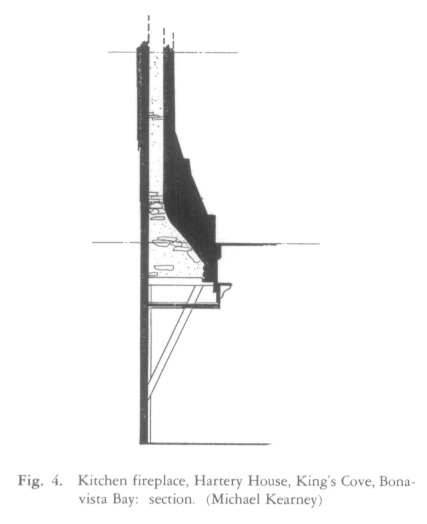 Display large image of Figure 4
Display large image of Figure 45 Only examples with stone chimneys are known to have survived, examples from the latter end of the development pattern. Photographs from the beginning of the twentieth century show studded chimneys but these have since gone. Two stone hood chimneys are to be found on the Bonavista Peninsula but they are of uncertain date. The first, in a house in Tickle Cove, involves a hood carried on an eight-by-eight-inch mantel beam which in its turn is carried on two beams of similar dimension cantilevered out from the back wall of the fireplace (fig. 3). The beams all have a deep chamfer and this, in conjunction with the woodwork about the fireplace, suggests that the structure may be eighteenth century - a date which would be as unusual for a Newfoundland building as the fireplace itself. The fireplace in the parlour of the house has been boarded over but significantly, in terms of dating, has no mantel shelf, only a fairly flat moulding of a late eighteenth- or early nineteenth-century pattern. The chimney is set centrally in the house - a plan normally (although not always reasonably) associated with settlers of Irish origin but also occasionally found in houses built by English settlers. It is possible that this house may have been English in origin.
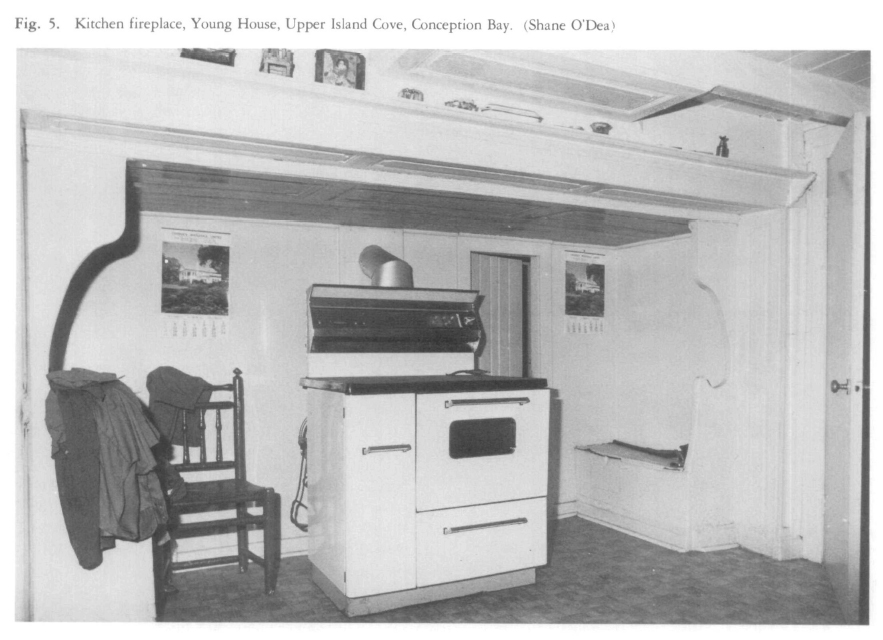 Display large image of Figure 5
Display large image of Figure 56 The other hood fireplace is found in King's Cove, Bonavista Bay, in a house likely built by settlers of Irish origin in the second quarter of the nineteenth century (fig. 4). As large as the previous example, this fireplace differs from it in that the hood is carried on two diagonal struts that reach from the fireplace to the cantilever. It is also unusual in that there are two fireplaces like this in the same structure, it having been a double house.
7 A number of stone, enclosed fireplaces survive, many of them on the Avalon Peninsula with the greatest concentration on the north shore of Conception Bay. Two that were demolished in South Side Carbonear in 1975 may have been built in the eighteenth century. The smaller of the two, the Fraize/Blackmore house, had a massive fireplace that filled the whole of the western gable and was six feet deep by sixteen feet wide - almost a third of the size of the kitchen that contained it. The other, in the Taylor/Fraize house, was of similar size and position, but the first house was a small one and the second a large merchant house. Similar fireplaces can be found in Brigus, Upper Island Cove, and Harbour Grace (fig. 5).
8 The centrally located settle fireplace is generally found in houses of Irish Newfoundlanders. White's in Beachy Cove, Gladney's at the head of Windsor Lake, and Cramp's on the Freshwater Road in St. John's all contain settle fireplaces which still have their settles. All three fireplaces measure five feet in depth and have an eight foot opening (fig. 6). These houses were all built about the middle of the nineteenth century and all served as farm houses. And we should note here that this whole concept of a warm room about the fire did not disappear with the disappearance of the settle fireplace. In at least one house, that of the Gregorys at Admiral's Beach in St. Mary's Bay, the kitchen stove is set in a portion of the kitchen (approximately twelve by four feet), which appears to have contained a large chimney (fig. 7). In fact the house was built in 1901 and never contained anything larger than a single flue chimney so that the idea of being able to sit about the fire was retained even when no fireplace was present.
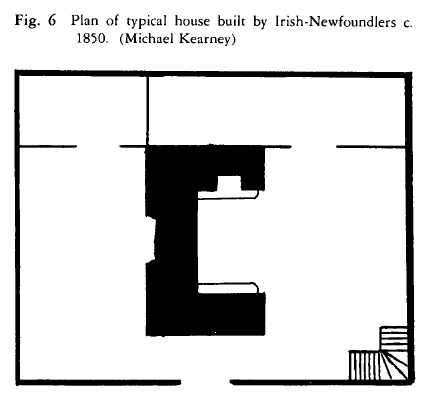 Display large image of Figure 6
Display large image of Figure 69 Similar fireplace and hearth types are found throughout western Europe and these Newfoundland examples are very similar to those found by Caoimhin Ó Danachair throughout Ireland. Wooden chimneys were not uncommon in Ireland, the caulking compound being clay as opposed to moss. The hooded fireplace is found but possibly not of the size of the Newfoundland examples. Of the stone, enclosed fireplaces it would be difficult to distinguish an Irish one from a Newfoundland one.5
10 The open fireplace with reduced opening appeared in Newfoundland about the beginning of the nineteenth century and generally involved the use of "dog-irons" and sometimes a grate to carry the fire. The introduction of iron appliances into the fireplace had occurred at a very early stage in European history and it is likely that they were fairly generally used in Newfoundland from the beginnings of occupation. The dog-iron was certainly common enough at the beginning of the nineteenth century and was replaced only gradually by the iron grate. This grate raised the fire above the hearth, improving the draft, concentrating the fire, and thus increasing its efficiency. The grate consisted of a face of four of five bars of which the top bar pivoted so that it could be lowered for clean out. It stood about eight inches above the hearth and was generally not more than eight inches deep. On either side of it would have been hobs which served as working or warming areas. Above the grate stood a crane on which, by means of hooks or a trammel, pots could be suspended above the fire.6
11 About mid-century the major changes occurred. At that point the last of the settle fireplaces were built, stoves came into common use, and small coal grates were regularly installed in houses. But the most important change was a clear differentiation of the technology for cooking and heating. Cooking was now done either on a cook-stove, a kitchener, or a range; heating was by a coal grate or some form of parlour stove. This is not to suggest that such items were not available in Newfoundland before 1850 but that they only came into common use about that time. The theory of heating design had been considerably advanced in the eighteenth century by Count Rumford and Benjamin Franklin. Rumford redesigned the fireplace so that it was much smaller and more efficient than any grate. But such items were not that common in Newfoundland at the beginning of the nineteenth century. Grates were sufficiently rare ro merit mention in the advertisements for the sale of houses. For example George Winter specified the presence of a kitchen range as well as grates in all the rooms when he offered his house for sale in 1815.7
12 As early as 1813 local merchants were offering stove grates, Bath stoves, and Rumford's ovens for sale. It is difficult sometimes to determine what these terms refer to but it would appear they were grates for use in heating. Apart from the basic grate mentioned before which was probably the production of local blacksmiths, the oldest known manufactured grate is one from Fort Townshend which is a government-issue hob grate or Bath stove made of cast iron in which the grate is supported by two panelled ends. A similar grate made by the Carron Foundry (a Scots firm in which Robert Adam's brother was a partner) is to be found in the Ridley Offices in Harbour Grace built in 1836 (fig. 8).
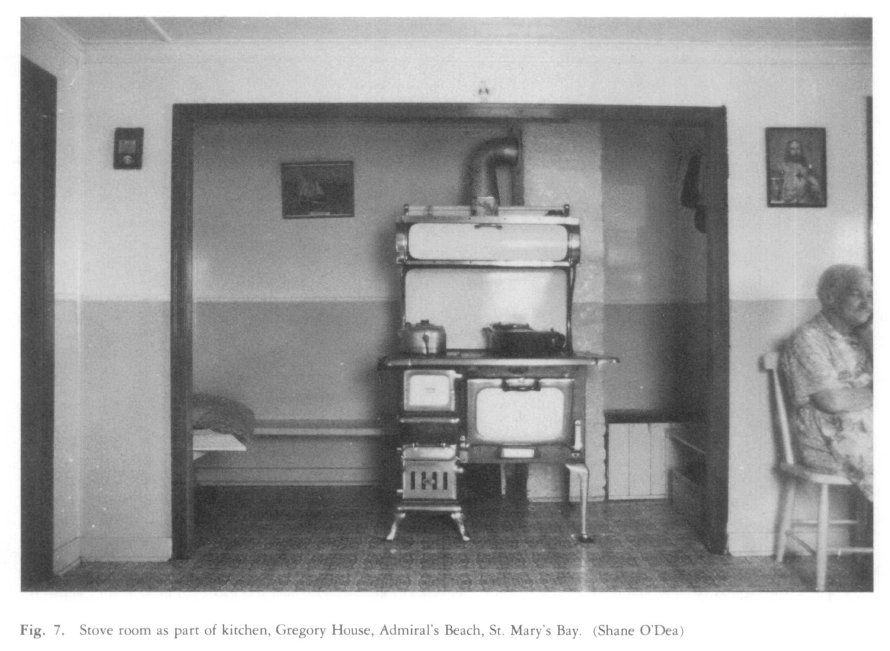 Display large image of Figure 7
Display large image of Figure 713 Later forms of the hob grate are made with an entire surround such as the one that came from the residential portion of a Water Street merchant's premises. Of cast iron decorated with wheat-sheaves, the surround was made to fit into the whole fireplace opening. The serpentine hob grate, which is of a piece with the surround, is a small coal grate approximately eight inches square. Its fireback is bolted to the surround and it has a hinged smokeshelf (to allow for cleaning the chimney) with a five-inch oval hole in it to allow the smoke to escape. This amounts to a considerable reduction in size from the opening of the settle fireplace, yet this fireplace was installed after the 1846 fire about the time the last settle fireplaces were being constructed. The Gothic grates are the ones most commonly found in Newfoundland and were available from the 1860s onwards. They consist of a rather ungothic semi-elliptical surround with rope-braid decoration. The surround supports a removable, iron coal basket and the fire-back is constructed of firebrick angling towards a smokeshelf which is set just below the top of the surround. It is also possible to find entire cast-iron mantel/surround/grate units in houses constructed in St. John's after the 1892 fire.
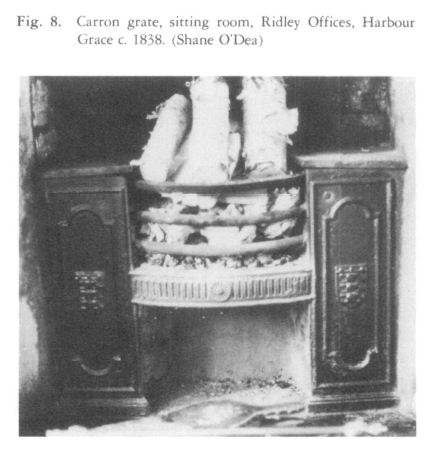 Display large image of Figure 8
Display large image of Figure 814 The taste for large fireplaces of an antiquarian nature returned at the end of the nineteenth century with the Queen Anne style of architecture. Prevalent elsewhere in the last quarter of the century, the style did not come to Newfoundland until the first decade of the twentieth. However, its large, generally open fireplaces owe their origins not to any Newfoundland architecture, which would have been beneath the consideration of the bourgeoisie who built these houses, but to American colonial or European architecture. The examples found in St. John's consist of ingle-hooks and great chimney-pieces with medieval hoods all of which have inserts of efficient contemporary grates.
15 One of the earliest references to what might be called a parlour stove is to be found in George Cartwright's Labrador journal of 1770 in which he speaks of his men having just set up a Buzaglo stove in his house.8 Stoves turn up in the earliest newspaper advertisements and they include Canadian and Register stoves. The greatest flood appears in the 1860s when George Gear and Robert Peace begin to compete for the local retail trade with a surprising variety of models. But these did not come into use without some uncertainty in the market, for a story is told that one of these gentlemen, presumably Peace, had ordered a large stock of dog-irons but found they were unsaleable because of the growing popularity of stoves. So Peace found a talkative and obliging customer who was willing to go up to Gear's and request some dog-irons while at the same time make disparaging remarks about stoves. Peace managed to persuade a number of his cronies to do this in the course of the morning. When Peace encountered Gear later in the day he began to moan about the fact that he was unable to get rid of his dog-irons and Gear, commiserating, said, "Well, I'll tell you what I'll do as a gesture of friendship. I'll take them off your hands at cost." Peace, expressing extreme gratitude, had the irons sent up immediately, and Gear had them on his hands for some time before they were sold for scrap. The stove had taken over even if it did project into the room and was regarded by those of antiquarian bent as destroying that old English institution — the open fire.9
16 With advances in heating technology came advances in cooking technology; the spits supported by dog-irons and the bake pot placed in the fire were superseded at the end of the eighteenth century by kitcheners and kitchen ranges (fig. 9). The kitchener was invented by Thomas Robinson in 1780 and consisted of an oven and a grate placed side by side. This made the operating surface more compact and somewhat less back-breaking than the open fire method. It also provided a large, fixed, closed oven with direct heat which could provide for both oven-top and fire-top cooking.
17 These items came into more general use within a short period of time. In Newfoundland they were installed in the old Government House at Fort Townshend and in the commissariat, as well as in several houses of the wealthy. One had to be wealthy to own a kitchener or a kitchen range since they cost £11 in 1818 (when a Bath stove cost £3). The kitchen range, with an oven on either side of the fire, developed from the kitchener and makes use of one fire to heat two ovens by means of draft controls. The two appliances, always set into an opening in the chimney, can be found in a number of St. John's houses built between 1818 and 1910. Curiously enough they have not been found in any outport houses — mercantile or other.
18 Two other forms of stove should be mentioned to indicate the level of technology Newfoundlanders had access to. In 1816 James Bayly had for sale "a new patent steam kitchen (36" x 24" with 22" x 29" roaster and 22" hot closet) and range complete with pipes for warming the room over or adjoining the kitchen."10 This appears to involve a form of early steam radiation. The other item was one Richard Brown offered for sale two years later — a "New Patent Gass Stove."11 Both items suggest a technology far in advance of what might be expected, but no examples are known to have survived, perhaps because the steam kitchen cost £60 and the Gass Stove 24 guineas.
19 The free-standing cook-stove — of which the Waterloo is the best-known form — became prevalent in Newfoundland about 1860 when George Gear was able to offer his customers a range of seven British-made and twelve American-made cook-stoves. In 1863 local demand was such that he presented the Terra Nova Cook Stove, "got out by the subscriber especially for the use of this country" and made in Britain. By 1870 local foundries had begun stove production. Of these the most important was the Consolidated Iron Foundry in which the Angel family were involved as well as Gear and Peace. They did have trouble getting under way in the face of American competition, and it was not until 1880 that protective tariffs enabled them to compete with imports. In 1871 Peace could advertise seven Newfoundland cook-stoves under the headlines: "Would you be surprised to learn that NEWFOUNDLAND MADE STOVES are equal to any produced in Britain or the United States?"12 As with any boom, a number of people got involved in the industry, but only two survived to 1890.
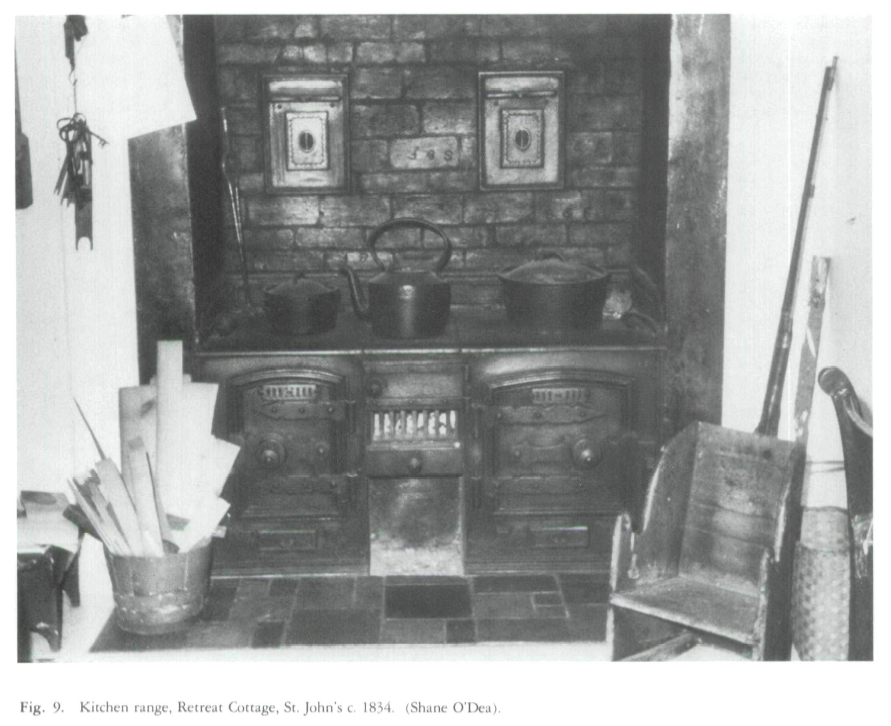 Display large image of Figure 9
Display large image of Figure 920 These stoves, like the old open fireplace, soon became a focal point or rather the dominant point in the kitchen. In older houses they were placed in the open fireplace where, while leaving space, they lost some of their effectiveness in providing heat to the room. When set out in the room and connected to the single-flue chimney by means of a pipe they became the centre of the kitchen with their hanging rods above and their wood-boxes to one side. The settle, which once sat in the fireplace, now moved out to one of the walls where the man could take his rest while keeping an eye on his fish, his children, or his neighbours through the window beside him. In fact the settle, by this change, seems to have become predominately a male preserve — the place where he slept after coming in from fishing and to which he retired in old age.
